By Evelyn Nguyen, May 19, 2025
Standing proudly as the “Roof of Indochina”, Fansipan Mountain in Sapa has long been at the top list for adventurous travelers and nature lovers alike. On a Sapa day trip to this misty highland town, conquering Fansipan offers breathtaking views of the Hoang Lien Son range by cable car or on foot.
This guide by Incredible Asia Journeys is everything you should know before going to this place: from the best routes and the right season to travel, to what to expect once you’re above the clouds.
Fansipan is the highest mountain in Vietnam and all of Indochina (Vietnam, Laos, and Cambodia), with a height of 3,143 meters above sea level. It belongs to the Hoang Lien Son mountain range with rugged beauty and rich biodiversity.
For many years, Fansipan has been a dream destination for adventure lovers who want to conquer the highest peak in the region. Today, thanks to the modern cable car system, even families and casual travelers can easily reach the summit and enjoy the amazing views above the Northwestern mountainous area in Vietnam.

Fansipan Mountain Peak in Sapa
Fansipan is called the “Roof of Indochina” because it is the tallest mountain on the Indochina Peninsula, ranking as the highest point in all of Vietnam, Laos, and Cambodia. The nickname reflects the mountain’s height and its symbolic meaning for those who climb it.
Standing on the summit, surrounded by clouds and mountain peaks, many visitors feel like they are truly on top of Southeast Asia. This title has also helped Fansipan become one of the most iconic travel spots in northern Vietnam.
Fansipan is located in Lao Cai Province, in northwestern Vietnam, about 9 kilometers from Sapa town. The mountain lies within the Hoang Lien National Park, an area famous for its beautiful scenery, rare plants, and ethnic minority villages.
How to get to Fansipan from Hanoi? From Hanoi, Fansipan is around 315 kilometers away. Most travelers first travel from Hanoi to Sapa, which takes about 5-6 hours by highway bus or 7-8 hours by overnight train. Once in Sapa town, you can easily reach the Fansipan Cable Car Station by taxi or shuttle bus, which takes around 15-20 minutes.
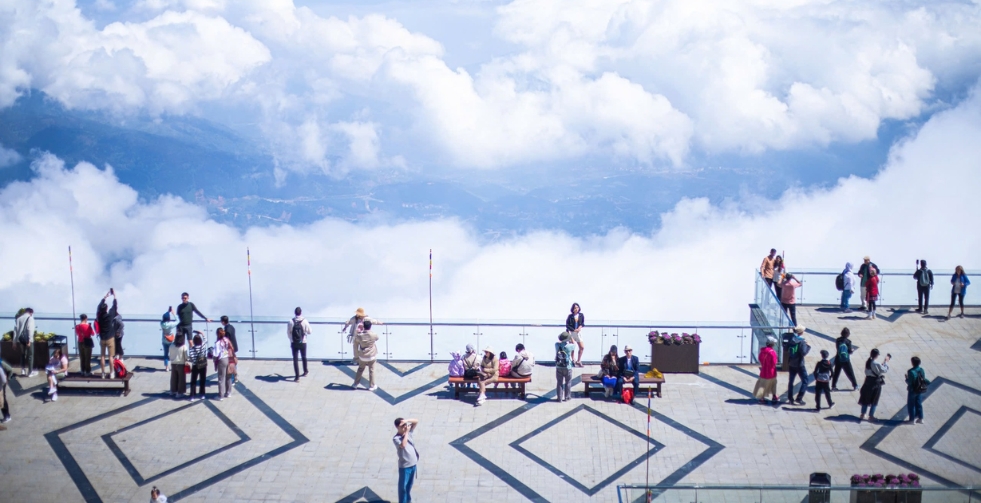
From Sapa town, the most common way is to go to the Fansipan Cable Car Station, located in Muong Hoa Valley, about 3 km from the town center. Tourists can get there by taxi, motorbike, or shuttle bus, which takes around 10-15 minutes. Many hotels in Sapa also offer FREE transport services to the station.
How to trek from Sapa town to Fansipan Mountain? If you plan to hike, your trekking route will also start near Sapa, with local guides leading the way through forests and mountain trails, with three main trekking paths:
This is the most popular trekking route, starting from Tram Ton Pass, about 15 km from Sapa town.
The trek takes 2 days and 1 night, leading hikers through scenic landscapes of the Hoang Lien Son Mountain Range and Muong Hoa Valley.
Starting from Sin Chai Village, only 4 km from Sapa, this route is shorter but steeper, suitable for experienced trekkers. The trek can be completed in about 9 hours, usually in one day, and passes through quiet forested areas.
Beginning at Cat Cat Village, just 3 km from town, this is the longest and most challenging route, taking about 3 days to complete.

Trekking to Fansipan Mountain
There are 2 main ways to reach the top of Fansipan: by cable car or by trekking.
Cable Car: The ride is the easiest and fastest option, taking only about 15 minutes with beautiful views of the mountains, valleys, and clouds. It’s suitable for all ages and fitness levels.
Sapa Trekking Tour: The hike takes 1-3 days, depending on the route. You’ll walk through forests, bamboo groves, and even camp overnight. Trekking is best for those who enjoy nature and physical activity.
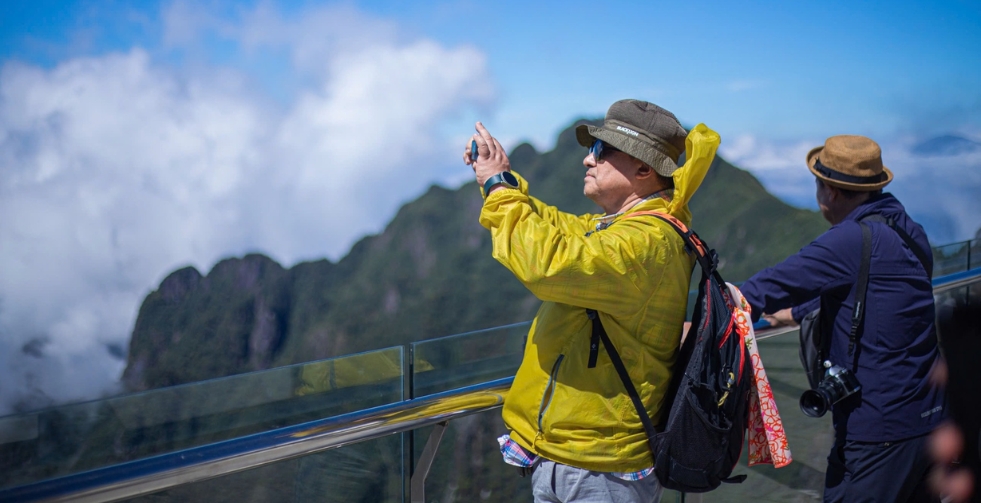
The viewpoint from Fansipan Mountain
>> If you want great views with little effort, choose the cable car. If you love adventure and don’t mind the hard work, go for the trek.
The Fansipan Cable Car is one of the longest and highest cable cars in the world. It starts from Muong Hoa Station and ends near the summit of Fansipan. From the top station, you’ll need to climb around 600 steps (or take a short funicular train) to reach the highest point.
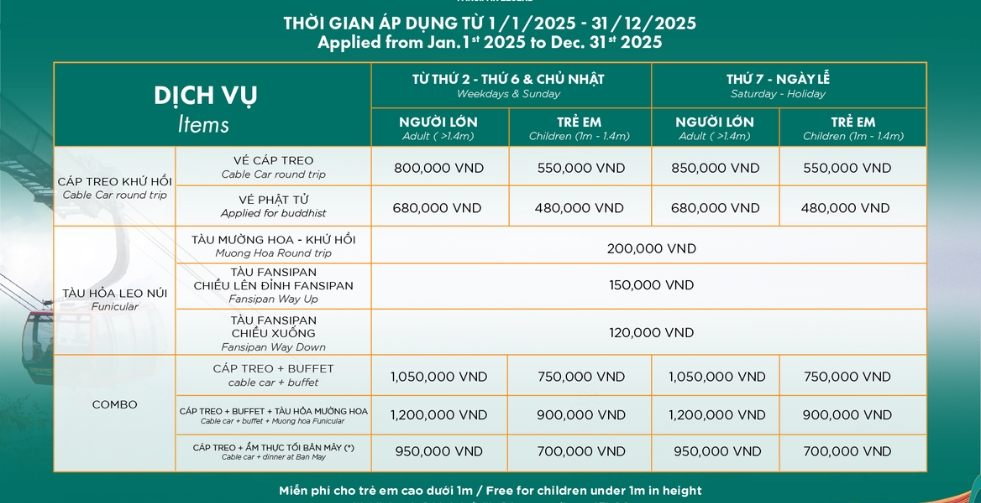
Fansipan Cable Car Ticket in 2025
Ticket Price of Sun World Fansipan Legend (as of 2025):
The journey from Sapa town to the summit of Fansipan Mountain typically has 3 stages:
Step 1: Transfer from Sapa town to the Fansipan Cable Car Station
Located in the Fansipan Legend Tourist Area, about 3 km from Sapa town.
You can get there by taxi, electric cart, or even by the Muong Hoa (Sapa) climbing mountain train (funicular), which connects directly from Sun Plaza in the town center to the lower cable car station (ticket required).
Step 2: Fansipan Cable Car Ride
The cable car ride takes about 15 minutes, carrying passengers over scenic Muong Hoa Valley, thick forests, and steep cliffs.
It ends at the Fansipan cable car arrival station, located at around 3,000 meters above sea level.
From here, you're just a few hundred meters below the actual summit.
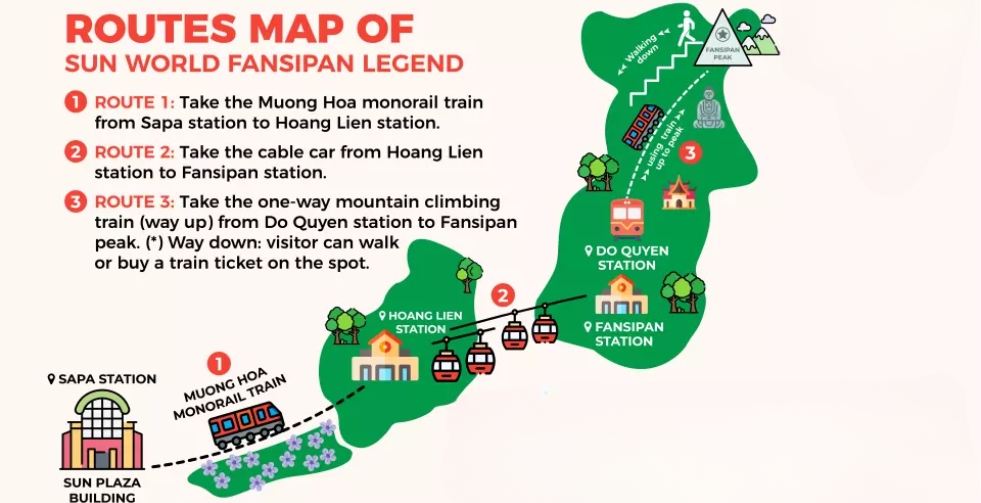
Route map of Fansipan Cable Car
Note: The Fansipan Cable Car usually undergoes annual maintenance, during which it temporarily suspends operations. For example, in 2025, the cable car was closed from January 8 to January 18 for system maintenance.
Before planning your trip, it's highly recommended to check the official Sun World Fansipan Legend website or their social media channels for the latest updates on maintenance schedules.
Step 3: 2 Options to Complete the Final Stretch
Takes around 15-30 minutes, depending on fitness.
Along the way, you can stop at temples, viewpoints, and spiritual monuments.
A short 2 to 3-minute ride that brings you right to the base of the summit.
Requires an additional ticket, usually purchased at the top station.
Important Note: Many people confuse the Muong Hoa funicular with the Fansipan cable car. The Muong Hoa train is only the first or final stage, not the main transport from Sapa.
Most Fansipan Mountain treks start from Tram Ton Pass, about 15 km from Sapa, and follow steep forested trails with stunning mountain views. There are three main options: the 1-day trek is the hardest, taking 8-10 hours of non-stop hiking, or the 2-day 1-night trek is the most popular, with a night spent at a 2,800m campsite in basic wooden huts or tents, and the 3-day trek with a slower pace for beginners.
All treks require a licensed local guide, and porters help carry food and camping gear. Groups are usually small (4-10 people), and meals are cooked on the trail.
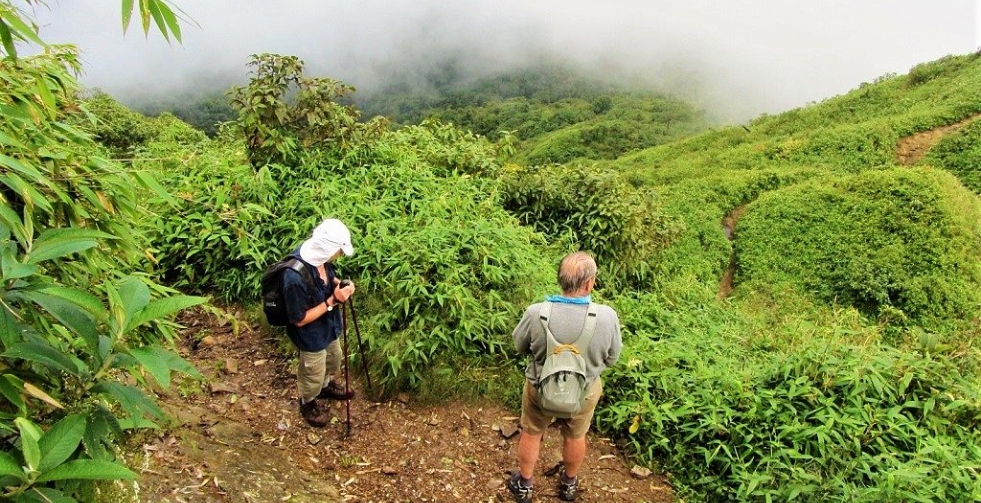
On the way to conquer the Fansipan Mountain
Fansipan Mountain is best visited between September and April, when the weather is generally dry and stable. During this period, the skies are clearer, which means better views from the summit and safer trekking conditions. Late September to early October in Sapa is especially beautiful, as the rice terraces in the surrounding valleys turn golden, a favorite time for photographers and nature lovers.
Snowfall on Fansipan is rare but possible in deep winter, especially from late December to February. When cold air fronts hit northern Vietnam, temperatures at the peak can drop below zero.
In such conditions, light snow or frost may appear, turning the mountaintop into a surreal white landscape. Visitors hoping to witness this should monitor weather forecasts closely and prepare for freezing conditions, especially early in the morning.
What to do in Fansipan? The Fansipan peak area is the highest point and also a large tourist complex, including spiritual works, photo areas, stone steps, and sightseeing routes. From the Fansipan cable car station, visitors will go up 600 more stone steps or choose the Muong Hoa mountain train to reach the top. Along the way, there are many stops to admire the majestic mountain scenery and take photos.
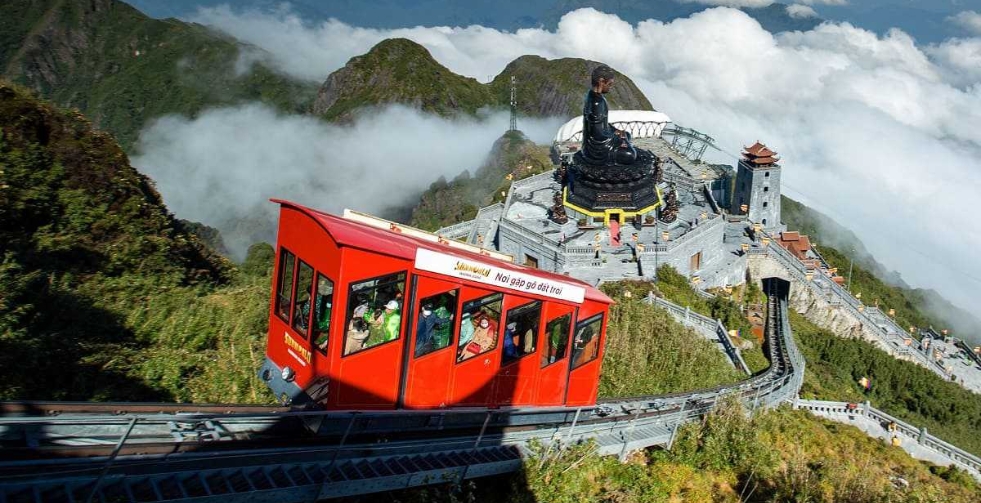
Muong Hoa mountain train to reach the top
Fansipan Peak is where the 3,143m milestone is located - the symbol of the “Roof of Indochina”. Next to it is the Vietnamese flagpole, which is often windy. The air at the top is thinner than usual, it is windy and cold, so you need to wear warm clothes and move slowly. Early morning or after rain is the ideal time to hunt clouds and have a long-range view.
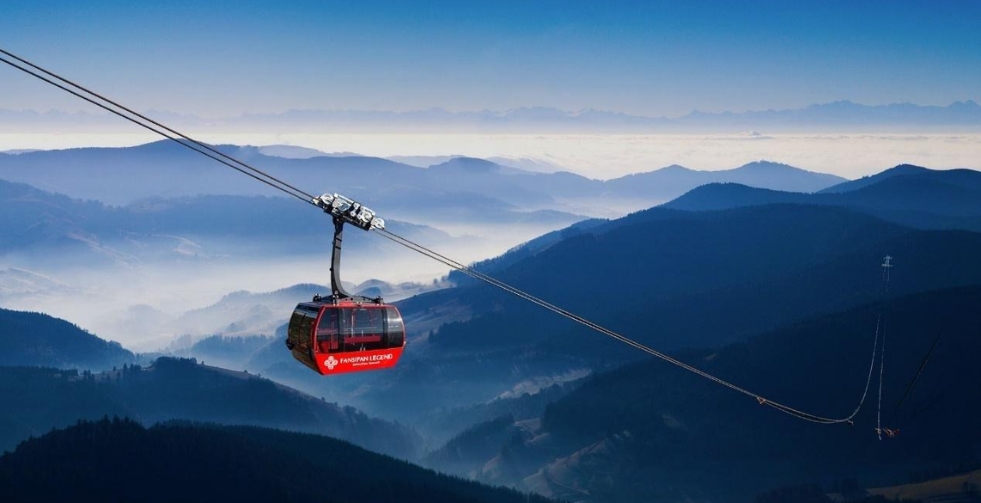
Fansipan Cable Car
The spiritual area is scattered from the cable car station to near the top of the mountain, including many works such as:
Note: Visitors should wear good shoes because the road has many stone steps, which can be slippery in the rainy season or early morning when there is fog.
On the Fansipan Mount cable car: Enjoy the panoramic view of Muong Hoa valley, terraced fields and clouds, and mountains. Sitting on the right side of the cabin in the direction of departure will give you a better view.
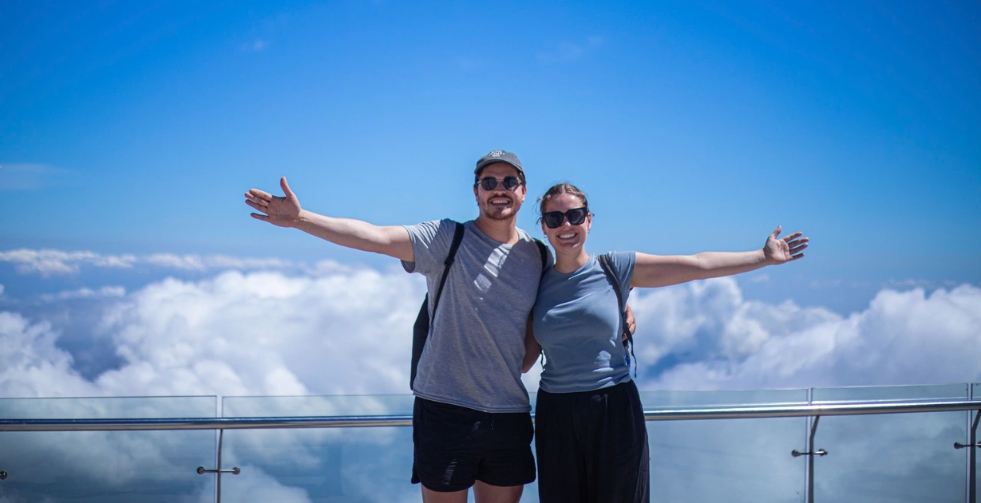
Check-in from the top of Fansipan Mountain
Yes. A round trip from Sapa using the cable car and funicular can easily be done in half a day. Trekking, however, takes 2–3 days and requires planning.
You should wear warm, layered clothing as temperatures on the Fansipan mountain are much cooler than in Sapa town. Comfortable walking shoes are also recommended, especially if climbing stairs.
Yes. The cable car is modern, safe, and suitable for all ages. For those who don’t want to climb stairs, the short funicular ride to the summit is a convenient option.
Yes. There are food stalls and a restaurant at the cable car stations. However, prices are higher than in Sapa, so you may also want to bring snacks and water.
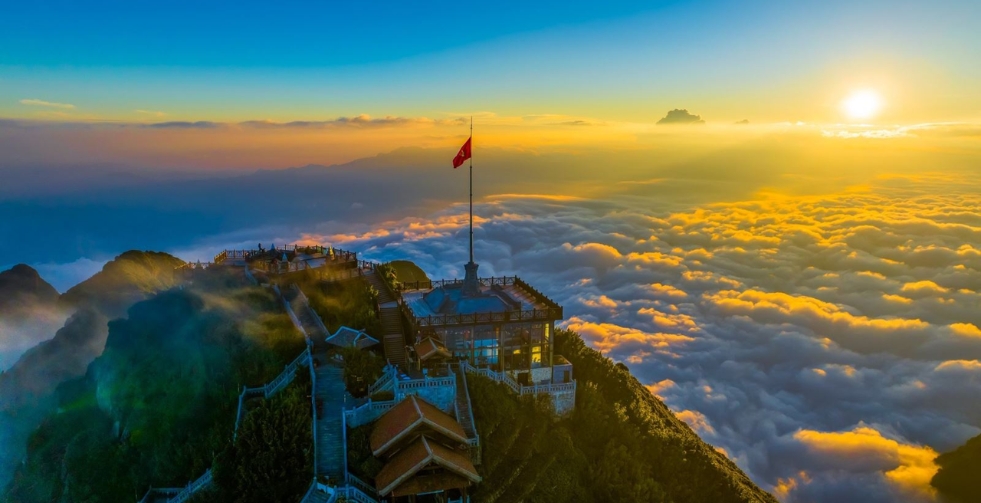
The peak of Fansipan Moutain
So, after this Sapa travel blog about how to go to Fansipan Mountain, hope that you can find the right way to conquer the highest mountain in Southeast Asia. If you’re looking for local travel support to explore Fansipan Mountain in Sapa, feel free to contact us for personalized advice, Sapa trekking tours, or cable car tickets.